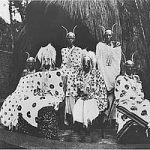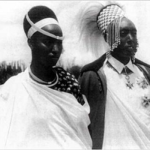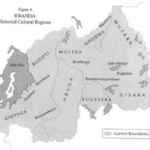Dual Genesis Traditions on Ijwi Island
Genesis traditions have longbeen important to historians of Africa, but recently interest in these forms of oral data has intensified with the development of analytic tools ultimately derived from structural anthropology. Where historians have applied these techniques, they have usually referred to a “tradition” (obtained from a single source or reconstructed from several sources to form a single tradition). Hence writers often refer to “the oral tradition” of a society in the singular. Even where two such traditions have been noted for a single people, these refer to the arrival of separate dynasties, composed of different peoples, located in different areas, and arriving at different times.
But oral sources even within a single society are multiple; they not only relate to different groups but also are recounted by different—specific—individuals. This essay considers two separate genesis traditions that both refer to the arrival of a single dynasty on Ijwi Island in Lake Kivu (Zaire). The traditions appear to be distinct in three ways: they are recounted by members of different groups; they refer to different events within the larger episode of royal arrival; and they exist today in very different forms. Each tradition is associated with a particular social group (in one case a “clan,” in the other a “subclan”); both groups, the Baloho and the Babambo, identify with the principal nonroyal figure in the tradition that each recounts. Despite their small size on Ijwi today, both of these groups claim a historical importance greater than their present status on Ijwi would otherwise indicate.
What is most remarkable about these two traditions is that they are exclusive of each other, and each is, with very few exceptions, known only by informants from within one of the two clans in question. Members of one clan do not know the traditions held by the other; when asked to identify a person mentioned in the other tradition, for example, an informant might be able to associate the character with the proper clan, but could provide no other information about this ties to royalty—the principal subject of the tradition. Even those with close contacts at the central court—including those from within the royal family itself—do not recount a full version of the royal arrival and do not combine elements from the two traditions examined here. It is clear, therefore, that the primary social function of these traditions is not simply that of justifying kingship or explaining royal presence to the Ijwi population as a whole. The traditions are much more localized than such an interpretation would allow; each is important only to the social group that holds it.
In addition to the distinct distribution patterns of the two traditions, there are differences in the traditions themselves, both in terms of content and in terms of the form in which they are narrated today. Aside from common reference to Mwendanga, the first king of the Basibula dynasty on Ijwi, events that figure prominently in one tradition have no reflection in the other, nor could people who know one tradition identify episodes in the other tradition. The two traditions also differ in form—in the kinds of events included and in the way in which they are recounted. One is a longer narrative recounted in greater detail with references to precise events and individual names. The other contains few direct references to individual names and discrete events; instead, it is characterized by vague references to broad cultural themes that are not today an important part of Ijwi society. Each version consists of elements that relate primarily to the “possessor” group; this specificity of the traditions, as also their localization to two small social groups, speaks to the lack of political socialization and cultural integration directly associated with royalty in the Ijwi kingdom.
In summary, then, on Ijwi there are two traditions relating to royal arrival that appear mutually exclusive: the individuals who know one do not know the other, the elements and events in one never appear in the other, and the two traditions are very different in form. This text inquiries into how it is that two such different traditions can relate to the same episode (the royal establishment on Ijwi) and why they have remained so distinct from each other and of such a narrow distribution on Ijwi over a considerable period of time. What follows will discuss the traditions in light of the sociological characteristics of the two clans that recount them; it will relate the traditions to the historical role of each “possessor” clan; and it will consider how the two traditions evolved over time, indicating some of the historical factors acting on these changes.
The traditions discussed here refer to the relations of two clans with a single segment of the Basibula dynasty, the ruling family of the Havu peoples, who live on the western shores of Lake Kivu and on the islands in the lake. Though the senior line of the dynasty is today located in Mpinga, on the Zairian mainland, the junior line is located on Iwji Island, an island about 25 miles long and including an area of approximately 150square miles. The separation of these two dynastic segments took place in the aftermath of a succession dispute to the Havu throne, a dispute that occurred at the southern end of Lake Kivu late in the eighteenth century. Following this dispute, the descendant of the unsuccessful claimant traveled to Ijwi, where he established the present dynasty on the island. How this occurred is the subject of the traditions discussed here.
The population of Ijwi, numbering today (i.e., 1975) about fifty thousand and forming a dozen major clans, is neither culturally nor historically homogeneous, for even within certain clans there are important differences in the time of their arrival on Ijwi and their immediate points of origin. Although many families came with or after the establishment of the present dynasty on Ijwi, an important proportion of the population arrived prior to that time. Many came from east of the lake, from areas that are today part of Rwanda; others came from west and north of the lake, while the royal family itself arrived on Ijwi from the south. Furthermore, the different populations on Ijwi (referred to collectively as the Bany’Iju) have experienced different influences from mainland areas over the nineteenth and twentieth centuries, and these influences have affected the nature and type of cultural change each has undergone. The cultural heterogeneity associated with such diverse influences is an important element in understanding the nature of the distinctions between the two traditions, as will be discussed below.6
Conversely, differences in the content of the traditions testify to the strength of the cultural differences on Ijwi in the past (and to their continuity through time), as well as to the specific events associated with the arrival of the Basibula dynasty about 150years ago. The events of royal arrival are privileged in one tradition. The other emphasizes those features that differentiate current conceptions of a former way of life from the mainstream of present Ijwi culture; in the process, it also vividly associates the presence of royalty on Ijwi with a given (nonroyal) clan. These two different levels of historical data (that of specific events on the one hand, and that of tracing broad trends of cultural change on the other) are also reflected in the different narrative forms of the traditions; together with their differences in content, these markedly different literary forms would seem to argue for their independence as historical testimony and hence also for the historical validity of their essential convergence on events: that Mwendanga, asa “royal orphan” (i.e, without the support of his own agnatic kin), sought alliances and arrived on Ijwi from the south. The two traditions relate in various ways to the same events and tend to confirm each other both in the nature of Mwendanga’s arrival and in the rough dating of these events (from genealogies and tie-ins). This not to say that all elements of the narratives are “true” as historical events, not even those elements shared (or implied) by the two traditions—that is, that the first monarch on Ijwi arrived as an orphan. It means only that he accomplished his ends independently of his agnates and therefore the story is to be told more in terms of other clans and Mwendanga’s relations to them than in any definitive narrative of the royal family—a Basibula narrative.
https://uk.amateka.net/dual-genesis-traditions-on-ijwi-island/https://uk.amateka.net/wp-content/uploads/2023/12/Bushi.pnghttps://uk.amateka.net/wp-content/uploads/2023/12/Bushi-150x150.pngHistory of kingsSocial & cultureGenesis traditions have longbeen important to historians of Africa, but recently interest in these forms of oral data has intensified with the development of analytic tools ultimately derived from structural anthropology. Where historians have applied these techniques, they have usually referred to a “tradition” (obtained from a single source...BarataBarata rpierre@ikaze.netAdministratorAMATEKA | HISTORY OF RWANDA




